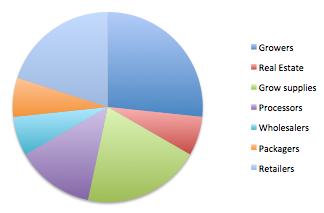Cannabis Market Sectors – Show me the money!
Very generally, the cannabis market can be divided into:
a) Licensing, Real Estate, Construction, Growing – collectively referred to as “Growers” – there are small and large growers; and
b) Regulatory Consultants, Construction, nutrient/light/HVAC suppliers, extractors/processing equipment, testing, wholesalers, packagers, retailers – collectively referred to as “Service Providers”.
Some Growers stick to growing (remaining “horizontal”) while some have become active in Service Provider sectors (becoming “vertically-integrated” in that they have internal extraction/packaging facilities). What I’d like to know is what activities/sectors offer the highest potential profits with the strongest potential growth. The following is not about which company may offer the best opportunity – rather it is only about which activity/sector may offer the best opportunity. So far the vast majority of invested dollars have flowed into the Growers resulting in significant risk that supply will exceed demand as the already-funded supply comes online over the next 18 months. I was at a top-level cannabis financial conference in Toronto recently and it was clear to me that the financial world believes that raw cannabis “bud”, is simply a commodity and that extracts, branding and consumer access are key to acquiring and maintaining market share. Additionally, the trend is that “extracts and oils” are growing at a much higher rate than traditional bud smoking and underlying this trend is the desire of industry to move away from the “stoner” image in order to transition the cannabis market into a true consumer product. Image is very important to mainstream acceptance.
The well-funded large Growers are reacting by investing not only in huge growing operations (internally or by acquisition), but also in extracts, brands and retail outlets. They want vertical integration to secure both production and consumer access for that production. Their financial clout provides them with the ability to “buy their way in at any price” as well as being able to weather the supply-glut storm that may be forming on the horizon. The issue is that there are numerous big Growers and when a market-share battle starts it can easily lead to a price war with the inevitable price drop not only harming the direct battle participants, but killing the not-so-well-funded small grower (for purposes of this essay, small growers are those that grow less than 1000 plants per crop cycle). The current valuations and potential looming battle leads me to stand aside from the Grower sector until this sorts itself out.
Is this the end for the small growers? I believe it’s actually the beginning of a new phase. Why? At the end of the cannabis chain is the consumer and the consumer always wants choice. As the craft beer/wine/spirit (they’re all alcohol-based) markets have taught us, consumers will buy and pay more for real or perceived value-add – whether it be taste, smell, potency, referral-by-a-friend or simply a well-designed label, consumers don’t buy only what the big guys are selling. This implies that for small growers to survive they must move beyond the commoditized raw bud market into the value-added, branding game (remember that retailers want to offer choice so they are predisposed to offer craft products/brands alongside any large Grower products). Only then can the small grower hope to compete with the large Grower. And herein lies the opportunity for Service Providers to profit from providing services/equipment to the legions of small growers (there are WAY more small growers than there are large Growers) wanting to establish their own brands and market share. So which Service Providers are in the sweet spot?
a) definitely retailers (physical and online) as they control the final exit point for the products – preferably independent. These guys have the potential to be speedy consolidators resulting in single point control over a large number of outlets. However, one has to be wary of valuations; and
b) since the big growth is in extracts/edibles, the small grower needs extractors to extract cannabinoids as the basic feedstock. There are different types of extractors for different types of feedstock extracts. Edible extracts can be made very cheaply using alcohol extraction while vapour pen extracts are significantly more expensive due to the nature of the equipment involved. While edibles are being heavily promoted, and are supposedly selling like mad, in my opinion there is a negative fundamental issue with “dosing” edibles as each person can have a different reaction to the same dose and the final effect is not known for quite some time after ingestion. This can easily lead to over/under consumption and a less-than-pleasurable experience. On the other hand, with vapour pens the effect is almost immediate and dosing is easily varied by the user. This leads to an optimum experience. But there is also an issue with vapour extract – there can be residual solvent left in the extract and residual solvent is bad. This residual is associated with highly-dangerous butane/propane-based extracts and there is a trend away from using such hydrocarbon-based solvents – particularly by the medical community. This leaves “zero-residual” CO2-based extracts as the preferred feedstock for vapour pens and I believe that the large Growers also believe this as is evidenced by many of them buying large CO2-based extractors. This leads me to think that CO2 extractor manufacturers represent a sweet spot in the overall cannabis arena. But there are some problems with this thought:
1. there are numerous CO2 manufacturers all competing for a relatively-limited number of large Growers – meaning there is “margin squeeze” that can negatively affect the profitability of these manufacturers; and
2. CO2 extractors have been expensive and beyond the reach of most small growers. This means that small growers who want to participate in the highly-lucrative vapour market have been relegated to using the declining and out-of-favour butane/propane hydrocarbon extractors and this is why I designed and built a small-scale CO2-based extractor targeting the small grower. Additionally, Canada’s Micro-grower/micro-extractor licenses could prove fertile ground for MEDXtractor extractors.

Recent Comments